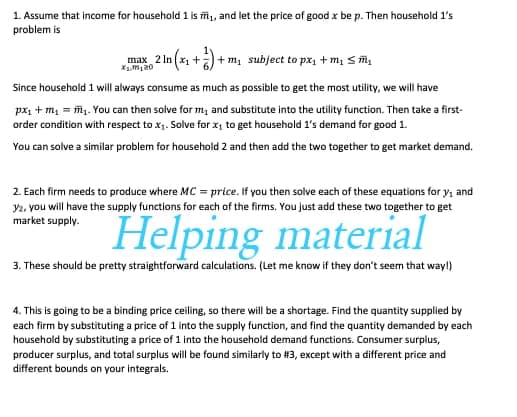3. Find the competitive equilibrium price for good 1, as well as the equilibrium de- mand of each household, the equilibrium supply for each firm, the households' utility in equilibrium, the firms' equilibrium profits, the consumer surplus, the producer surplus, and the total surplus.
3. Find the competitive equilibrium price for good 1, as well as the equilibrium de- mand of each household, the equilibrium supply for each firm, the households' utility in equilibrium, the firms' equilibrium profits, the consumer surplus, the producer surplus, and the total surplus.
Microeconomics: Principles & Policy
14th Edition
ISBN:9781337794992
Author:William J. Baumol, Alan S. Blinder, John L. Solow
Publisher:William J. Baumol, Alan S. Blinder, John L. Solow
Chapter5: Consumer Choice: Individual And Market Demand
Section: Chapter Questions
Problem 3DQ
Related questions
Question
Q3 solution needed. another pic is just for helping material

Transcribed Image Text:1. Assume that income for household 1 is mi, and let the price of good x be p. Then household l's
problem is
max 2 In (x1 +) + m, subject to px, + m, s ĩ,
Since household 1 will always consume as much as possible to get the most utility, we will have
px, + m, = mg. You can then solve for m, and substitute into the utility function. Then take a first-
order condition with respect to x1. Solve for x, to get household 1's demand for good 1.
You can solve a similar problem for household 2 and then add the two together to get market demand,
2. Each firm needs to produce where MC = price. If you then solve each of these equations for y, and
y2. you will have the supply functions for each of the firms. You just add these two together to get
market supply.
Helping material
3. These should be pretty straightforward calculations. (Let me know if they don't seem that way!)
4. This is going to be a binding price ceiling, so there will be a shortage. Find the quantity supplied by
each firm by substituting a price of 1 into the supply function, and find the quantity demanded by each
household by substituting a price of 1 into the household demand functions. Consumer surplus,
producer surplus, and total surplus will be found similarly to #3, except with a different price and
different bounds on your integrals.

Transcribed Image Text:2. Find the supply function for good 1 of each firm and the market supply function for
good 1, and illustrate each firm supply and the market supply curves in a graphic.
3. Find the competitive equilibrium price for good 1, as well as the equilibrium de-
mand of each household, the equilibrium supply for each firm, the households' utility
in equilibrium, the firms' equilibrium profits, the consumer surplus, the producer
surplus, and the total surplus.
4. Suppose that a price ceiling of 1 is put in place. Under the assumption of efficient
rationing, find the supply of each firm, the consumption for each household, the new
consumer surplus, the new producer surplus, the new total surplus, and the surplus
loss in relation to the competitive outcome.
Expert Solution
This question has been solved!
Explore an expertly crafted, step-by-step solution for a thorough understanding of key concepts.
This is a popular solution!
Trending now
This is a popular solution!
Step by step
Solved in 2 steps with 2 images

Recommended textbooks for you

Microeconomics: Principles & Policy
Economics
ISBN:
9781337794992
Author:
William J. Baumol, Alan S. Blinder, John L. Solow
Publisher:
Cengage Learning



Microeconomics: Principles & Policy
Economics
ISBN:
9781337794992
Author:
William J. Baumol, Alan S. Blinder, John L. Solow
Publisher:
Cengage Learning



Exploring Economics
Economics
ISBN:
9781544336329
Author:
Robert L. Sexton
Publisher:
SAGE Publications, Inc


Economics (MindTap Course List)
Economics
ISBN:
9781337617383
Author:
Roger A. Arnold
Publisher:
Cengage Learning